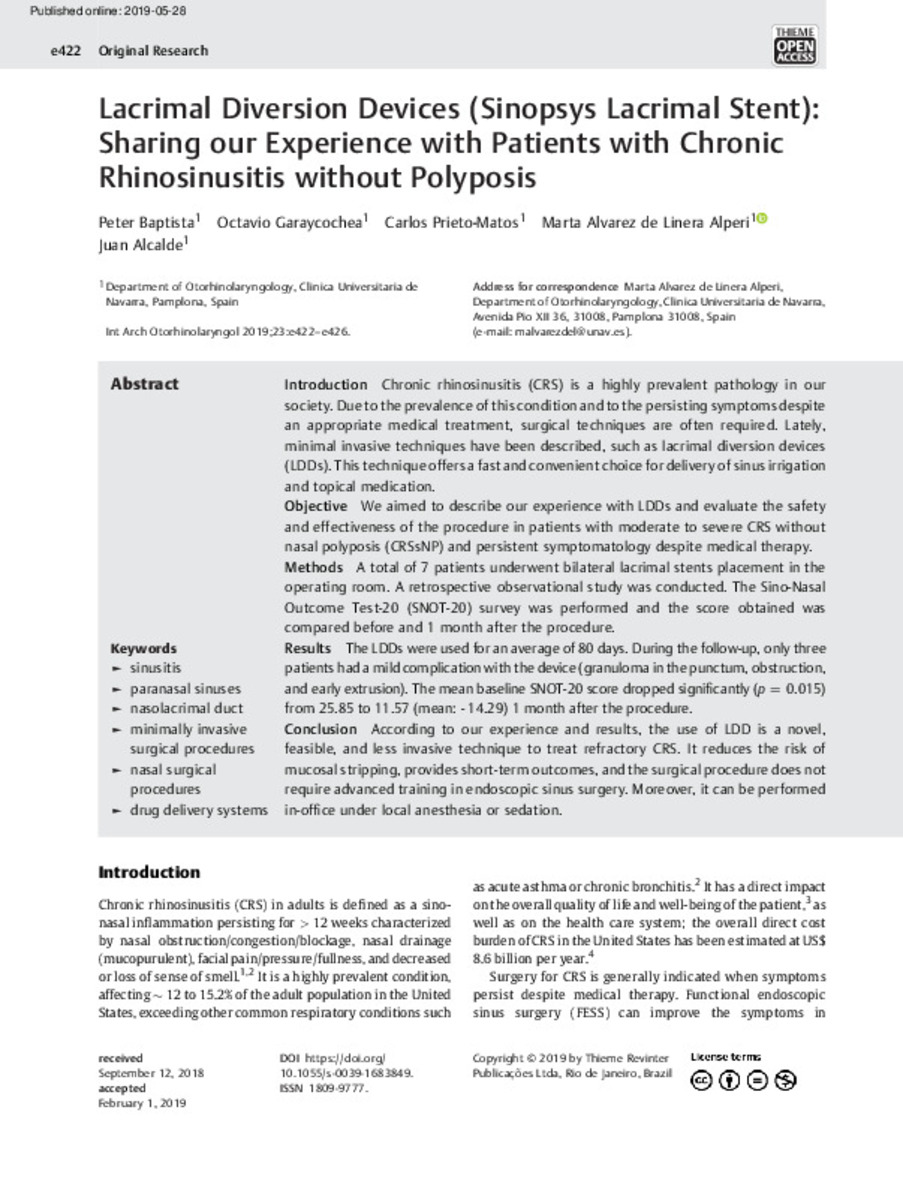Registro completo de metadatos
| Campo DC | Valor | Lengua/Idioma |
|---|---|---|
| dc.creator | Baptista, P.M. (Peter M.) | - |
| dc.creator | Garaycochea, O. (Octavio) | - |
| dc.creator | Prieto-Matos, C. (Carlos) | - |
| dc.creator | Álvarez-de-Linera-Alperi, M. (Marta) | - |
| dc.creator | Alcalde, J. (Juan) | - |
| dc.date.accessioned | 2021-09-09T12:26:11Z | - |
| dc.date.available | 2021-09-09T12:26:11Z | - |
| dc.date.issued | 2019 | - |
| dc.identifier.citation | Baptista, P.M. (Peter M.); Garaycochea, O. (Octavio); Prieto-Matos, C. (Carlos); et al. "Lacrimal Diversion Devices (Sinopsys Lacrimal Stent): Sharing our Experience with Patients with Chronic Rhinosinusitis without Polyposis". International Archives of Otorhinolaryngology. 23 (4), 2019, e422 - e426 | es |
| dc.identifier.issn | 1809-4864 | - |
| dc.identifier.other | PMID: 31649762 | - |
| dc.identifier.uri | https://hdl.handle.net/10171/61980 | - |
| dc.description.abstract | Introduction: Chronic rhinosinusitis (CRS) is a highly prevalent pathology in our society. Due to the prevalence of this condition and to the persisting symptoms despite an appropriate medical treatment, surgical techniques are often required. Lately, minimal invasive techniques have been described, such as lacrimal diversion devices (LDDs). This technique offers a fast and convenient choice for delivery of sinus irrigation and topical medication. Objective: We aimed to describe our experience with LDDs and evaluate the safety and effectiveness of the procedure in patients with moderate to severe CRS without nasal polyposis (CRSsNP) and persistent symptomatology despite medical therapy. Methods: A total of 7 patients underwent bilateral lacrimal stents placement in the operating room. A retrospective observational study was conducted. The Sino-Nasal Outcome Test-20 (SNOT-20) survey was performed and the score obtained was compared before and 1 month after the procedure. Results: The LDDs were used for an average of 80 days. During the follow-up, only three patients had a mild complication with the device (granuloma in the punctum, obstruction, and early extrusion). The mean baseline SNOT-20 score dropped significantly (p ¼ 0.015) from 25.85 to 11.57 (mean: - 14.29) 1 month after the procedure. Conclusion: According to our experience and results, the use of LDD is a novel, feasible, and less invasive technique to treat refractory CRS. It reduces the risk of mucosal stripping, provides short-term outcomes, and the surgical procedure does not require advanced training in endoscopic sinus surgery. Moreover, it can be performed in-office under local anesthesia or sedation. | es_ES |
| dc.language.iso | eng | es_ES |
| dc.publisher | Georg Thieme Verlag KG | es_ES |
| dc.rights | info:eu-repo/semantics/openAccess | es_ES |
| dc.subject | Materias Investigacion::Ciencias de la Salud::Otorrinolaringología | es_ES |
| dc.subject | Sinusitis | es_ES |
| dc.subject | Paranasal sinuses | es_ES |
| dc.subject | Nasolacrimal duct | es_ES |
| dc.subject | Minimally invasive surgical procedures | es_ES |
| dc.subject | Nasal surgical procedures | es_ES |
| dc.subject | Drug delivery systems | es_ES |
| dc.title | Lacrimal Diversion Devices (Sinopsys Lacrimal Stent): Sharing our Experience with Patients with Chronic Rhinosinusitis without Polyposis | es_ES |
| dc.type | info:eu-repo/semantics/article | es_ES |
| dc.description.note | Reconocimiento-NoComercial-SinObraDerivada | es_ES |
| dc.identifier.doi | 10.1055/s-0039-1683849 | - |
| dadun.citation.endingPage | e426 | es_ES |
| dadun.citation.number | 4 | es_ES |
| dadun.citation.publicationName | International Archives of Otorhinolaryngology | es_ES |
| dadun.citation.startingPage | e422 | es_ES |
| dadun.citation.volume | 23 | es_ES |
Ficheros en este ítem:
Estadísticas e impacto
Los ítems de Dadun están protegidos por copyright, con todos los derechos reservados, a menos que se indique lo contrario.






